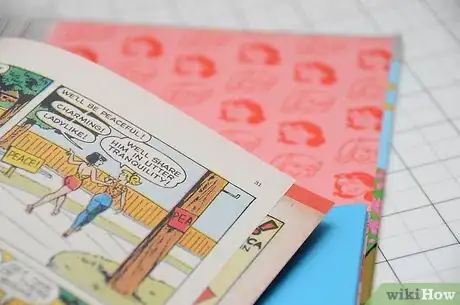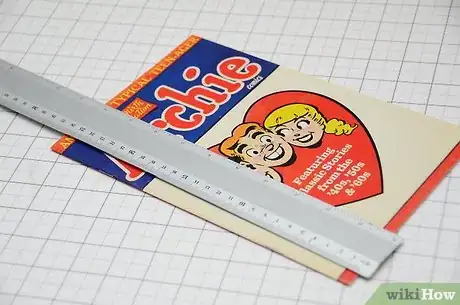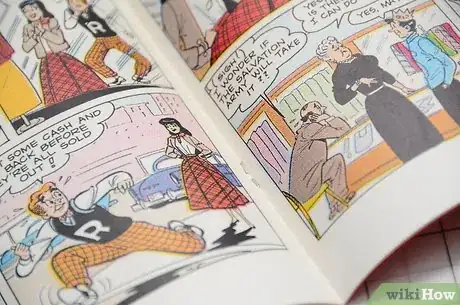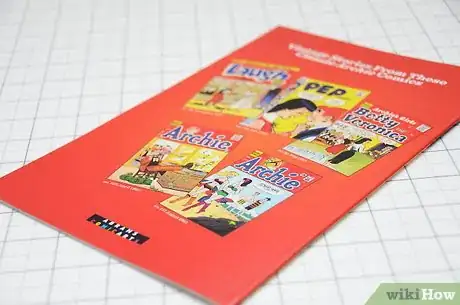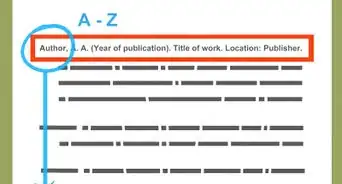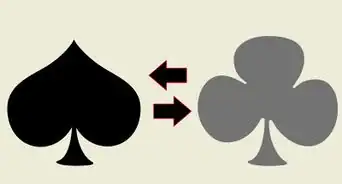wikiHow is a “wiki,” similar to Wikipedia, which means that many of our articles are co-written by multiple authors. To create this article, 9 people, some anonymous, worked to edit and improve it over time.
This article has been viewed 108,500 times.
Learn more...
The term "graphic novel" was first coined in 1964 by Richard Kyle in a newsletter published by the Comic Amateur Press Alliance. DC Comics used the term in 1972 for the second issue of its "Sinister House of Secret Love," but the first use of "graphic novel" for standalone works came 4 years later, for Richard Corben's "Bloodstar," George Metzger's "Beyond Time," and Jim Steranko's "Chandler: Red Tide." The term's popularity was ensured in 1978 with the trade paperback publication of Will Eisner's "A Contract with God, and Other Tenement Stories," which took its inspiration from the 1920s and '30s woodcut-illustrated novels of Lynd Ward. Because the practice of creating graphic novels pre-dates the term, there is some confusion as to what constitutes a comic book and what constitutes a graphic novel. Although there are no universally agreed-upon definitions of either term, the following steps offer a set of things to look for in how to distinguish between a comic book and a graphic novel.
Steps
-
1Determine whether the publication is a periodical or a single work. Although "comics" encompasses both comic books and graphic novels, a comic book is properly a magazine with volume and issue numbers. A graphic novel is properly a single publication, although some comic publishers have produced a line of graphic novels, as Marvel Comics did from 1982 to 1988 with its series of 35 works.[1]
- The use of the word "novel" in the pages of a comic book does not automatically make it a graphic novel. The 4-chapter "novel-length" stories of All-Flash Quarterly in the 1940s and the 3-part Superman "novels" in Action Comics and Superman of the late 1950s and early 1960s are not themselves graphic novels, because they were part of an overall comic book series of stories.
- A novel adapted to graphic form may or may not be a graphic novel. The novel adaptations in Classics Illustrated are not themselves graphic novels, because Classics Illustrated was published as a periodical. An adaptation of a single novel across several volumes, such as Jane Fancher's 3-volume adaptation of C.J. Cherryh's "Gates of Ivrel," although not covering the entire novel, may be considered a series of graphic novels by some and a graphic miniseries by others.
- Some comics are designated "one-shot" comics, such as "Superman vs. Muhammad Ali," published as an oversize (Treasury) edition in 1978. These comics usually have their own volume and issue numbers, usually the number 1. One-shots are not normally considered graphic novels.
-
2Note how many stories are contained between the pages. A comic book may contain a single story, 2 stories, or as many as 3 or 4 stories between its pages, which may or may not all have the same characters. A graphic novel normally contains only a single story with the same cast of characters.[2]
- Some bound reprint collections, such as "The Greatest Superman Stories Ever Told" and "The Greatest Batman Stories Ever Told," are as thick as graphic novels. These are not properly graphic novels themselves, because they contain more than 1 story, even if the stories feature the same main character. They can be called graphic anthologies, as they follow the format of prose anthologies, which are collections of short stories within a single genre and often with a common theme.
- Bound collections of single story arcs, such as Frank Miller's 1986 "The Dark Knight Returns," which was originally published as a 4-issue miniseries, or Alan Moore and Dave Gibbons' 1987 "Watchmen," originally published as a 12-issue limited series, are graphic novels because the comic book story arc constitutes a single story within its pages. Each story from the original multiple-issue format constitutes a chapter within the graphic novel.
- There have been some exceptions to the "one story" definition for a graphic novel. Will Eisner's "A Contract with God, and Other Tenement Stories" was a set of interrelated short stories bound in the same volume. (It should be noted that the term "graphic novel" was used only on the trade paperback edition and not the earlier hardcover edition.)
Advertisement -
3Count how many pages the comic contains. Comic books have a fixed length, which ranged from 64 to 96 pages during the early 1940s and today is around 32 pages. Graphic novels typically run longer, ranging anywhere from 60 to 500 pages. Archie Goodwin and Gil Kane's 1971 "Blackmark" ran 119 pages, and its sequel the following year ran 117, while the graphic novel collections of Dave Sim's "Cerebus" are nicknamed "phone books" by their fans because of how thick they are.[3]
- Many comics series produce special longer issues once a year. While these annuals may publish longer stories than the monthly comics with the same title, these cannot usually be considered graphic novels, even if they contain only a single story, as the issue is often identified with the word "Annual" and usually bears an issue number.
-
4Observe the dimensions of the comic. Comic books are typically published with a width of 6 5/8 inches (17 cm) and a vertical length of 10 1/4 inches (26 cm). Graphic novels may be published with this length and width, with the dimensions of a trade paperback, an oversize (Treasury) edition, or a digest-size comic.
- Trade paperbacks have a width of 5.32 inches (13.5 cm) and a vertical length of 8.51 inches (21.6 cm).
- Digest size has a width of 5 3/8 to 5 1/2 inches (13.65 to 13.97 cm) and a vertical length of 7 1/2 to 8 3/8 inches (19.05 to 21.27 cm).
-
5See how the comic is bound. Comic books traditionally have been bound with staples, much like prose magazines of similar size. Graphic novels, on the other hand, are usually bound the way thicker magazines and books are bound.[4]
- Note, however, that some higher-quality special comic books are bound like books. The individual volumes in the 3-issue "Subterraneans" Elseworlds miniseries featuring Batman feature high-quality paper and are not bound with staples, but the individual issues are not themselves graphic novels. The overall story, if bound in a single volume, would be a graphic novel.
-
6Note the quality of the paper used. For most of the decades they have been published, comic books have been printed on lower-grade matte-finish paper. Graphic novels and anthologies published from the 1980s onward typically are published on a higher grade of paper, either matte or glossy finish. However, many recent comic books have also been published on slick paper, even though they are still held together with staples.
-
7Look at the price. Because of the limited scope of their stories, their being single publications, and the higher quality printing and binding, graphic novels usually cost more than comic books.[5]
-
8Finished.
Community Q&A
-
QuestionHow many graphic novels are in the series, "Empowered"?
 Community AnswerAdam Warren wrote ten books in the series called "Empowered."
Community AnswerAdam Warren wrote ten books in the series called "Empowered." -
QuestionHow many books did Hidendori Kusaca make for Pokemon Adventures?
 Nir RasinCommunity AnswerThere are 9 original comics that were illustrated by Mato. Currently, there are 62 in Japanese, 58 of them have already been released in English. Number 59 will be released on January 10, 2023.
Nir RasinCommunity AnswerThere are 9 original comics that were illustrated by Mato. Currently, there are 62 in Japanese, 58 of them have already been released in English. Number 59 will be released on January 10, 2023.
Warnings
- Because graphic novels were produced before the term was officially applied to them, there is no agreement as to what was the first graphic novel. Candidates include Archie Goodwin and Gil Kane's 1971 sword-and-sorcery work Blackmark, which won a Shazam Award, their "His Name is � Savage" of 3 years earlier, the 1978 trade paperback collection of Jack Katz's "First Kingdom" series of 1974, and even the extended Doctor Strange story published in Strange Tales #130 to 146 during 1965 and 1966.⧼thumbs_response⧽
- A common semantics argument is that novels such as the ones by Charles Dickens were originally published in periodicals as installments. However, this served a practical purpose of assuring a novelist a paycheck at least once a month as opposed to once or twice a year, the average time it takes for a good novel to be written, edited, and completed. The format for these installment published novels was still a single story with a beginning, middle, and end and they were most certainly outlined in their entirety prior to being published, even if the ending wouldn't be seen for months. Watchmen, was originally published in the form of 12 monthly comic book sized installments but the format is most definitely a novel as Alan Moore meticulously plotted and scripted the series from beginning to end before the first issue was published.⧼thumbs_response⧽
- Some people in the comics industry object to the term "graphic novel," regarding it as a pretentious term used merely to avoid the stigma of comic books, or to justify charging more to sell a graphic novel than a comic book.⧼thumbs_response⧽
References
- ↑ https://knowledgenuts.com/2014/01/07/difference-between-comic-books-and-graphic-novels/
- ↑ https://knowledgenuts.com/2014/01/07/difference-between-comic-books-and-graphic-novels/
- ↑ https://blog.online-spellcheck.com/general/the-difference-between-comics-and-graphic-novels/
- ↑ https://www.mentalfloss.com/article/588430/comic-books-vs-graphic-novels-what-is-difference
- ↑ https://www.mentalfloss.com/article/588430/comic-books-vs-graphic-novels-what-is-difference
- http://en.wikipedia.org/wiki/Graphic_novel
- http://en.wikipedia.org/wiki/One-shot_(comics)
- Rodney Ruff, Omaha, NE; lifelong comics fan and collector of both comic books and graphic novels


